New TV Buying Guide: 5 simple steps to buying a new TV

Everything you need to know to buy a great new TV
If you’re planning on buying a new TV, it’s worth spending a little time researching it so you buy the right TV for you. It makes things much easier and you can be certain you’re buying a new TV you’ll be happy with for years to come. Our guide to buying a new TV will help you do just that.
Our TV buying guide will help you decide:
- What size and type of TV is best for you and the features you actually need
- How much you really need to spend when buying a new TV
- The inside tricks of the trade to find the very best TV deals on new TVs
Of course, you don’t have to follow every single step in our guide to buy a good TV, but each step tackles an important point along the way that should help you decide. Got a question? Leave a comment and we’ll do our best to help.
STEP ONE: Decide what size TV should to buy
Most people start here for the simple reason it’s the easiest thing to decide. Generally size is dictated by things like the space you have available or simply personal preference. But if you don’t have any space limitations or preference against large screens, there’s a simple way to decide the perfect size TV for you and that’s based on how far you’ll sit from the screen.
How far do you sit from your TV?
In an ideal world the distance between you and the TV would be the no.1 consideration. Picking the right size new TV is just like choosing the perfect seat at the cinema. You want be close enough to get a really good view, but not so close it’s uncomfortable.
A decent rule of thumb is you should sit a distance that’s 1.5 times the diagonal size (i.e. 32-inches) of the your TV. This ensures you see the extra detail available in Full HD pictures, and enjoy a view that immerses you in whatever you’re watching.
Here’s a quick size guide to help you.
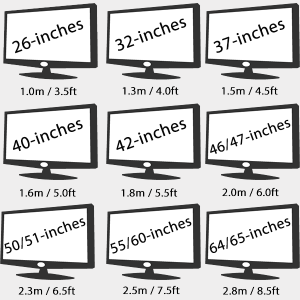
![]()
TRUSTED TIP: Generally, we recommend you buy the largest good TV you can comfortably afford. Extra features like smart TV are nice, but a larger TV will give a more immersive experience, particularly for films and games. It’s unlikely you’ll ever sit ‘too close’ to a TV unless it’s for a very small space.
![]()
STEP TWO: Decide what your ‘dealbreakers’ are
It’s much easier to pick the right new TV for you when you have a decent idea of what you actually need. It’s oh so easy to spend more than you need to otherwise. The easiest way to do this is decide on a few ‘deal breakers’.
These will probably include price (which we’ll get onto a minute), but also consider the features you genuinely must have and the ones you don’t really care about. Here are a few ideas to get you started.
If you want a smart TV, what features do you actually need?
Smart TV is basically like the apps on your smartphone; smart TVs let you access services like BBC iPlayer using your TV and the internet. Every brand’s system is different, and each one has features and services others don’t. Consider which ones you absolutely must have, such as BBC iPlayer or Netflix, and others you’re not too fussed about.
![]()
TRUSTED TIP: Upgrade your ‘smart’ experience
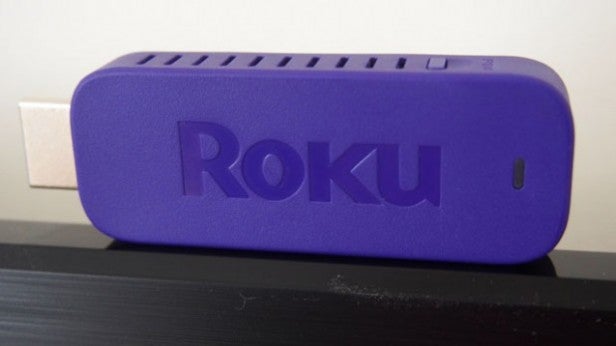
Products like the Chromecast, Now TV box, Apple TV and Roku TV Streaming Stick can add smart TV features to any TV for as little as £10 to £50. If you’re on a budget this may be the best way to get BBC iPlayer and similar services, rather than spending extra on a smart TV. Also read our Google Chromecast vs Roku Streaming Stick comparison.
![]()
Do you need Freesat?
In some areas the standard Freeview
signal is very weak. Freesat is the alternative that, as the name
suggests, uses a satellite dish instead. Some pricier sets have Freeview
HD and Freesat HD tuners, so you have the choice between using one or
both.
What connections do you need?
It’s always worth checking how many connections you need, and what type you need. For example, most TVs have three or four HDMI ports, but cheaper ones have fewer. It all depends on whether you plan to have lots of products connected to your TV, such as gaming consoles, cable or satelitte boxes or the smart products like Google Chromecast mentioned above. It’s a serious pain if you run out. Also, if you’re buying a smart TV, does it have Wi-Fi built-in and if not is that a problem for you?
![]()
TRUSTED TIP: There are alternatives to Wi-Fi
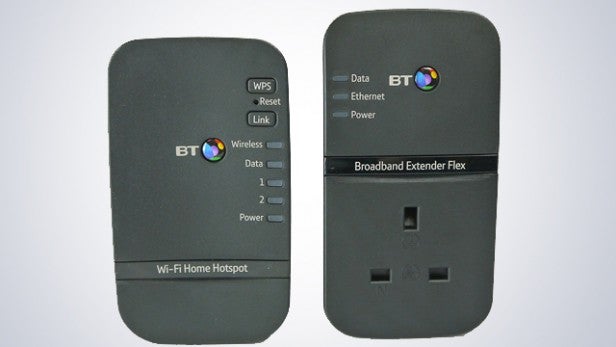
If your TV doesn’t have Wi-Fi, one option is to use powerline adapters. They use your home’s power sockets to send network signals around your house without any extra wires.
![]()
Do you play games often?
Skip this if you don’t, but if you do, particularly online multiplayer games, you may want to prioritise a TV with low input lag. Input lag is a measurement of the difference in time between you making an action and it appearing on screen, and a TV with high input lag can put you at a disadvantage. We test this on all TVs and less than 20/30ms is a good guideline.
Wall-mounting and stands
Do you want to wall-mount? If so, check the TV supports the standard VESA mounting system, or if it doesn’t that it has some other useful method. Most do, but the thinner and lighter the TV, the better for wall-mounting. It’s also worth double checking the wall you intend to mount the TV on, stud walls are often unsuitable. Alternatively you can use the provided pedestal but check it will fit on your TV stand as some recent TVs don’t fit well on older stands.
How important is picture quality to you?
You may not care too
much, but if you do consider what you care most about. If you mostly
watch films you may want a TV that has a particularly good ‘black level’
(how ‘black’ blacks look), or if you mostly watch during the day you
may prefer a TV that’s very bright and not too reflective. Sports fans should consider how well a TV handles motion. These are all things we look at when reviewing TVs.
![]()
TRUSTED TIP: You can upgrade most things apart from your screen
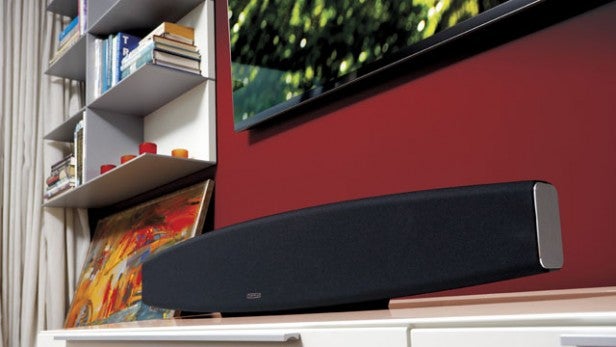
Remember that while you can add smart TV features, and better sounding speakers and soundbars later, no number of tweaks will fix a fundamentally bad TV. If you must choose between better pictures and other features, picture quality wins every time. Read our Best soundbar roundup
![]()
STEP THREE: Set a rough budget to work with
Once you know what size you want and the things you care about the most, it’s much easier to work out how much you really need to spend.
The best way to do this is set yourself a range, such as £500 to £700, that factors the absolute most you’re prepared to spend and the amount you’d be most comfortable spending. This is useful because quite often you can find TVs below your maximum budget that are as good, if not better. It’s a helpful way to ensure you don’t spend more than your really need to.
But what do you get for your money? Below we look at various price ranges, what you can expect to get and some good TVs worth considering in your budget.
![]()
TVs under £300: Small TVs and Budget TV Brands
You really don’t get much for your money from TVs under £300. Expect to pay £250 for a small TV (22 to 28-inches) from a known brand, and a little less for own brand TVs from retailers. These are the kind TVs that suffice for the kitchen or bedroom, but not much more. You’re unlikely to get smart features and if you do they will be basic.
If your budget is really tight, a second-hand TV is worth serious thought. You might be able to get a Recommended TV from two years ago for a steal and it will most likely be better than any new budget brand TV you can buy new.
See all TVs under £300
![]()
![]()
TVs £300 to £600: Decent 32 to 42-inch TVs
You’re on much safer ground in this price bracket. You can buy some decent 32-inch TVs around the £300 to £350 price range, and the higher you go the larger and better TVs you’ll find.
You can get 40-inch Smart TVs from £400 to £500, and you can get some good TVs from 32 to 42-inches for up to £600. They won’t always be the best for films, but they should be good everyday TVs. Most, but not all, will include smart TV.
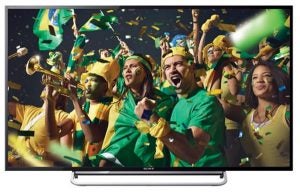 TrustedReviews Recommends
TrustedReviews Recommends
Sony KDL-40W605B (40-inch, £450)
It has no 3D and the speakers are only so-so, but this 40-inch TV puts many far more expensive TVs to shame with its outstanding colours and contrast. It’s one of our favourite TVs right now and it even has smart TV features.
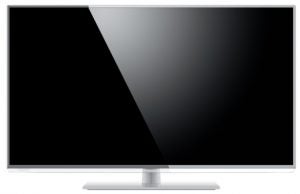 TrustedReviews Recommends
TrustedReviews Recommends
Panasonic TX-L32E6 (32-inch, £360)
If you need a 32-inch TV for a small living room, bedroom or kitchen, this Panasonic is a great choice. It’s one of last year’s models, so lacks its latest smart features, but it’s simple to use and the picture quality is great.
See all the Best TVs under £600
![]()
![]()
TVs £600 to £1,000: Good-Value TVs up to 55-inches
This is where the best value new TVs are normally found. TVs in this price range are often very good indeed and there are some great deals to be found. Most TVs between £600 and £800 will include all the latest features, such as Smart TV and 3D, at up to 50-inches in size.
TVs between £800 and £1,000 have similar features, but will either be larger or use superior picture processing systems to improve picture quality. That said, choose well and you can find TVs in the lower end of this price bracket that outperform more expensive alternatives.
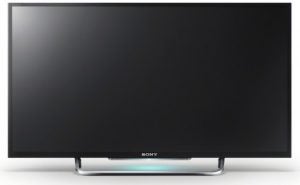 TrustedReviews Recommends
TrustedReviews Recommends
Sony KDL-50W829 (50-inch, £779)
Another outstanding Sony TV that delivers on all counts and is very good value for money. It’s also very stylish, comes with two pairs of active 3D glasses and has decent sound quality.
See all the best TVs £600 to £800
See all the best TVs £800 to £1,000
![]()
![]()
TVs £1,000 to £1,500: Fully-Featured TVs up to 55-inches
This is a tricky price bracket. Choose poorly and you can end up with a TV that’s only marginally better than cheaper models; choose well and you can get one of the best TVs on the market.
When you’re spending this much money it’s worth shopping around. Look out for TVs with very large price cuts in this price range as these are often last year’s top-of-the-range TVs and can be great deals.
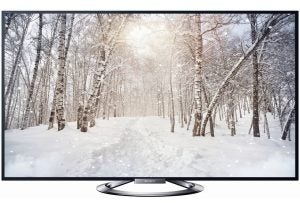 TrustedReviews Recommends
TrustedReviews Recommends
Sony KDL-55W905A (55-inch, £1,200)
Here’s a good example of what shopping around can get you. This is actually a 2013 model TV, but it’s still available and it’s absolute stunner. A huge 55-inch screen, great sound and sensational picture quality, all for half the price as when it first went on sale for £2,400. It has some weaknesses, but this is a great deal.
See all the best TVs under £1,500
![]()
![]()
TVs £1,500 or more: Large Full HD and 4K TVs
Most TVs at or above £1,500 are at least 55-inches and upwards. Most 4K TVs start from around £2,000, though prices are falling all the time.
It’s pretty hard to buy a bad TV at this price, and many will include Freeview HD and Freesat HD TV tuners and every feature (useful or not) going. If you’re spending this much, we’d strongly recommend buying a 4K TV and not a Full HD one. If you can’t afford one now, consider waiting until prices fall and maybe buy a cheaper TV to bridge the gap between.
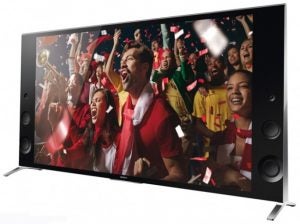 TrustedReviews Recommends
TrustedReviews Recommends
Sony KD-65X9005B (65-inch 4K, £3,400)
This is Sony’s flagship 4K TV. It’s awesome and there’s a cheaper, 55-inch version for around £2,000. This is close to a perfect TV. Stunning picture quality combines with great design and class-leading sound to stunning effect, though the extra speakers on the side make this TV even larger than usual. 4K Netflix is supported.
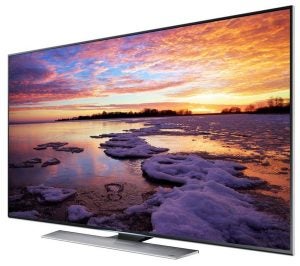
TrustedReviews Recommends
Samsung UE55HU7500 (55-inch 4K, £2,299)
Samsung’s 2014 4K TV is another stunner and it’s a cool £300 or so cheaper than Sony’s equivalent at the same size. The Sony is the better TV overall, but the Samsung is still outstanding and it isn’t quite as wide as it doesn’t have such prominent speakers. Support for 4K Netflix means you can start watching 4K straight away, too.
See all the best TVs over £1,500 ![]()
STEP FOUR: Create a shortlist of three TVs
By now you should ready to make shortlist of TVs. Try and whittle it down to three or so models, preferably a cheaper one, a more expensive one and something in the middle (depending on your budget) that fulfil your needs. It could be more or fewer TVs, but three is a good number to aim for.
If you need some help, we have plenty of places where you can start to narrow down your list:
Latest TV Reviews The latest TVs. We review over 100 TVs every year
10 Best TVs Round-Up Our recent favourites of every popular size and type
5 Best Value TVs Round-Up The best TVs for on sale for £500 to £600
Best 4K TVs Round-Up Our pick of the best 4K TVs you can buy now
And if you’re interested in a specific brand, try our pages for the best Sony TVs, best Samsung TVs, best Panasonic TVs and best LG TVs.
It’s always a good idea to check popular retailers as well, as they may stock TVs we haven’t reviewed yet that are worth considering. You might find there’s a very similar TV available for less, or a special deal worth considering.
As you create your shortlist, one obvious candidate may present itself, but if not it might come down to which TV you can find the best deal on, which leads us to the final step…
STEP FIVE: Find the best deal on your shortlisted TVs
We could tell you obvious things, like compare prices and so forth, but you can work that much out for yourself. We have some more useful tips, the kinds insiders know about and retailers would rather you didn’t.
Use CamelCamelCamel to check how good a deal you’re getting
It’s one thing to compare prices across retailers, but Amazon price tracker CamelCamelCamel
is far more useful. It tracks prices for products on Amazon across
time, which is super easy way to check whether the deal you’re getting
is as good as you think. You’ll be amazed how much prices fluctuate.
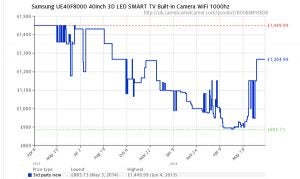
This example of a top-end Samsung TV is perfect. Here we can see that the price dropped consistently after Christmas, reaching a low of just £885 — a huge £564 saving on the price it started at a year earlier. This is also a prime example of our next tip to ensuring you get a great deal…
Pick the right time to buy your new TV
There are good and bad
times to buy TVs. The January sales are generally a good time to buy,
but don’t buy a new TV just before Christmas — it’s a seller’s market.
The absolute best time to buy a new TV
is between February and April. Why? Because this is when TV brands start
to introduce new models, meaning prices on the previous year’s TVs
should start to go down, sometimes by a huge amount. Some deals can be
found as late as May.
The run up to big sporting events, like the
World Cup, should be approached with caution. There are good deals to
be had, but don’t assume every deal is as good as it first seems as it’s
also a chance for retailers to make a fast buck.
Haggle for extras and price cuts
Yes, you read that right: haggle! Seen the TV cheaper elsewhere? Show the retailer and negotiate. While some stores might be sniffy, most want the sale and will do their best to match the price. Alternatively, see if they will throw in extras like HDMI cables, soundbars and other accessories you need to sweeten the deal. Obviously this only works on the high-street, but it’s worth trying if you get the chance.
![]()
TRUSTED TIP: Don’t buy expensive HDMI cables
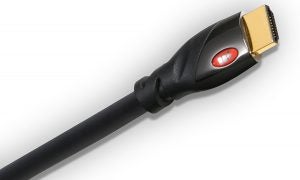
Don’t, whatever you do, be suckered into buying expensive HDMI cables. They make no difference. Sure they might look nicer and be slightly sturdier than the £3.50 one you can buy on Amazon, but HDMI is a digital cable. ‘Shielding’ or ‘gold plating’ make no difference to the quality of the picture. If you’re spending much more than £10 then you’re probably being ripped-off, and don’t be fobbed off with an expensive one to ‘sweeten the deal’.
![]()
Other things to consider
Follow those steps and you should be on your way to buying a very good new TV, but if you still have questions here are a few commonly asked questions and things worth considering before you buy.
LED vs Plasma: Which is best for you?
This used to be a big decision, but sadly it’s less so now. Plasma used to be the choice for discerning film fans, but various factors mean few companies actually make them anymore. Panasonic, which previously championed this type of TV, quit making them last year leaving just Samsung and LG, neither of which seem overly committed to plasma for the future. If you can find a good one now then plasma still offers the best experience for film fanatics, but plasmas are on the way out.
What is Ultra HD / 4K TV and should I buy one?
4K, aka Ultra HD, is the natural successor to the Full HD TVs most people are familiar with now. The most basic explanation is that 4K TVs use four times as many pixels as Full HD TVs to produce pictures, resulting in hugely improved picture quality. Read more in our What is 4K TV and Ultra HD? guide.
I’ve seen or heard about curved TVs, should I care?
Not too much would be our answer right now. Only Samsung and LG sell curved TVs and the pros and cons are up for the debate. If you like the look of them, however, our Curved TVs: Pros and Cons feature looks at them in greater detail.
Next, read our Tablet Buying Guide

